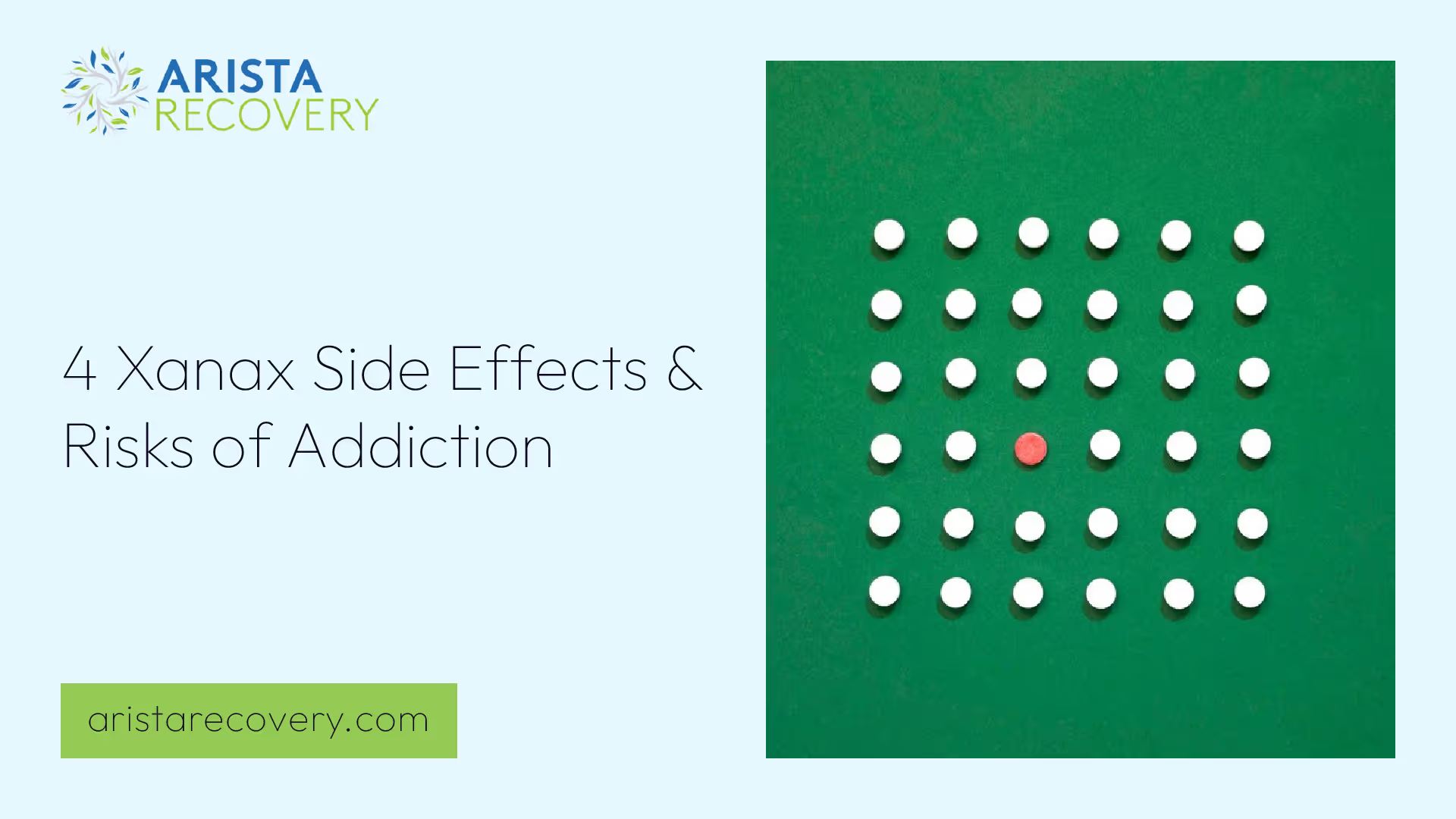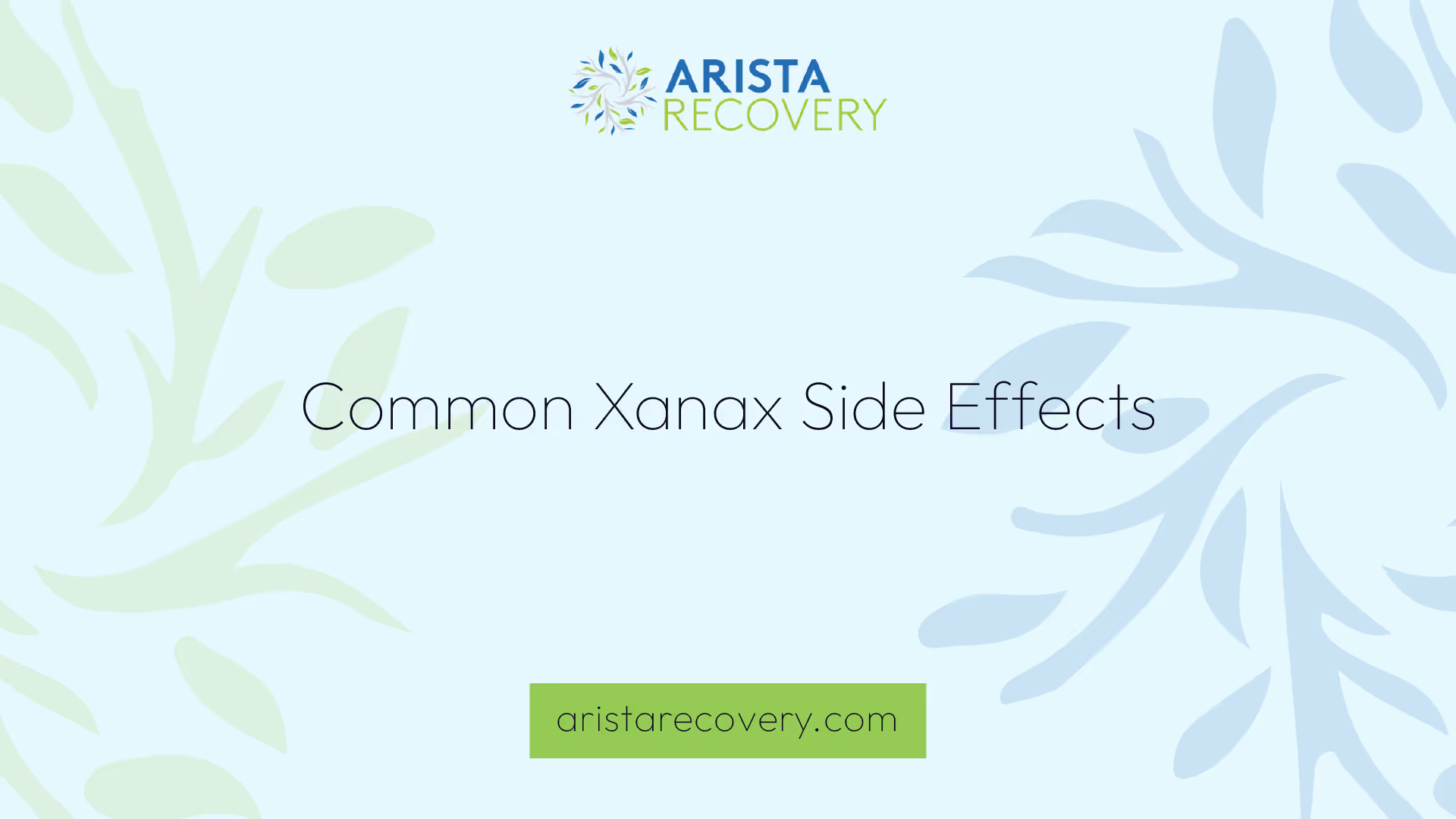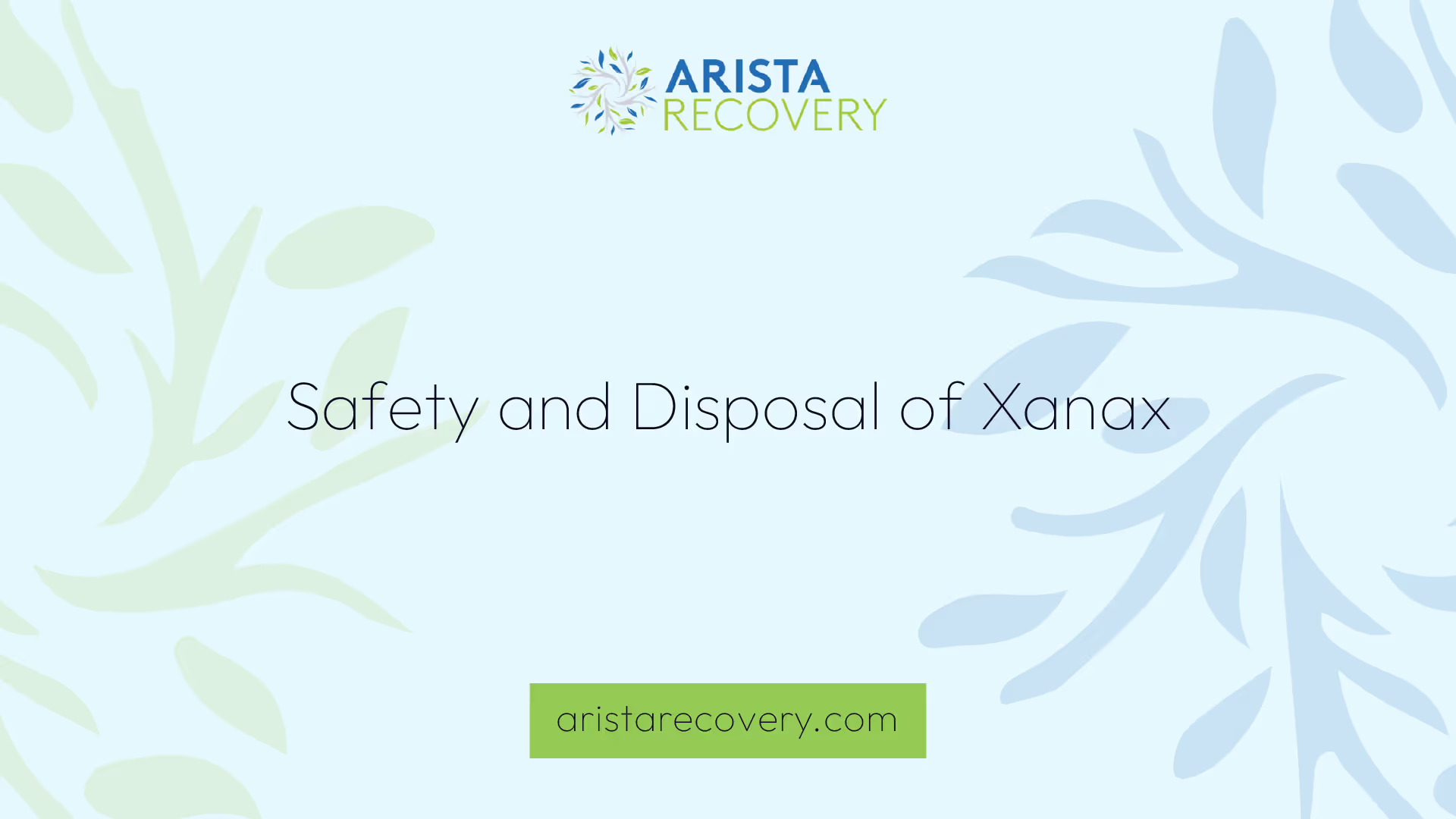4 Xanax Side Effects & Risks of Addiction


Understanding Xanax Addiction
When discussing the potential side effects of Xanax, it's crucial to also understand the risk of misuse and addiction associated with this medication. Xanax, also known by its generic name, alprazolam, has a boxed warning for the risk of misuse and addiction, and it is classified as a Schedule IV controlled substance.
Introduction to Xanax Misuse
Xanax is a prescription medication primarily used for treating anxiety and panic disorders. While it can be highly effective when used as directed, misuse of Xanax can lead to serious problems, including addiction. Misuse can involve taking higher doses than prescribed, using it without a prescription, or combining it with other substances, such as alcohol or opioids.
Combining Xanax with alcohol or other drugs that cause drowsiness or breathing problems, especially opioid medications like codeine or hydrocodone, can result in serious side effects, including death [2]. For a deeper understanding of the history and uses of this drug, read our article on the history of xanax.
Xanax and Risk of Dependence
Regular use of Xanax can lead to physical and psychological dependence. This means that an individual may start to feel that they cannot function normally without the drug. Over time, they may also develop a tolerance to the drug, meaning that they need to take larger doses to achieve the same effects.
Alprazolam may be habit-forming, and if an individual feels that the medicine is not working as well, they should not exceed the prescribed dose. It is recommended to call the doctor for instructions in such cases. If a person tries to stop using Xanax abruptly after developing a dependence, they may experience withdrawal symptoms. To understand what these symptoms may look like, visit our page on xanax withdrawal symptoms.
In conclusion, while Xanax can be an effective treatment for certain conditions, it's important to use the medication responsibly to avoid the risk of addiction. If you or a loved one is struggling with Xanax addiction, it's crucial to seek professional help. There are resources available to help manage addiction and ease xanax withdrawal symptoms.
Impact of Xanax on the Body
Understanding the impact of Xanax on the body is integral to grasping the repercussions of its misuse and the potential for dependence. In this section, we will explore the duration of Xanax in the body, and the factors that influence its effects.
Duration of Xanax in the Body
Xanax has a half-life of about 11 hours, which means it takes roughly 11 hours for the amount of Xanax in the body to reduce by half. It typically takes about 2.5 days for Xanax to be fully removed from the body [1]. However, this duration can vary based on individual factors, which we will explore in the next section.
Factors Affecting Xanax Effects
Several factors can influence how long the effects of Xanax last in the body. These include age, weight, ethnicity, metabolism, liver function, dosage, and the total length of time taking Xanax [4].
For instance, age plays a significant role in the metabolism of Xanax. The half-life of Xanax is higher in elderly individuals, with an average half-life of 16.3 hours compared to roughly 11 hours in younger, healthy adults.
Weight also influences the half-life of Xanax. For obese individuals, the half-life of Xanax is higher than average, ranging between 9.9 and 40.4 hours, with an average of 21.8 hours. This makes it more difficult for the body to break down Xanax.
In conclusion, while the average half-life of Xanax is about 11 hours, individual factors can significantly influence the duration of Xanax in the body. Understanding these factors is crucial for individuals taking Xanax and can help guide discussions about potential risks and dependencies. For more information on the effects of Xanax, explore the history of xanax and its potential withdrawal symptoms.

Common Xanax Side Effects
In the journey of understanding Xanax misuse, it's crucial to be aware of both mild and severe side effects associated with this drug. Regular use or misuse of Xanax may lead to a range of side effects, which vary in severity from mild discomforts to serious health risks.
Mild Effects of Xanax
Mild side effects of Xanax may include drowsiness, light-headedness, dry mouth, and increased saliva production. It's also common to experience changes in sex drive and ability, along with mood changes like anger [2]. These side effects are typically temporary, and they may go away within a few days to a couple of weeks.
However, if these effects persist or worsen, it's advised to inform the doctor or pharmacist promptly. The severity and duration of these mild side effects may vary depending on the condition being treated and the individual's overall health status.
Severe Side Effects of Xanax
While Xanax can offer relief for certain conditions, it also has the potential to cause serious side effects. These may include seizures, hallucinations, thoughts of suicide, and difficulty breathing. Other serious side effects can involve trouble speaking, loss of coordination, trouble walking, memory problems, and yellowing of eyes/skin.
If any of these severe side effects occur, it's important to contact a doctor immediately or call emergency services. Timely medical attention can help prevent these side effects from causing long-term damage.
Understanding these potential side effects is an important step in managing the risks associated with Xanax use or misuse. It's also crucial to consider the possibility of withdrawal symptoms, which can occur if the drug is suddenly stopped. For more information on Xanax withdrawal and how to manage it, visit our articles on xanax withdrawal symptoms and how to ease xanax withdrawal.
Xanax Withdrawal Symptoms
Understanding the withdrawal symptoms related to Xanax is an important aspect of managing and overcoming addiction.
Severity of Withdrawal
Xanax is a type of medication known as a short-acting benzodiazepine. The withdrawal symptoms for these types of medications can vary in severity and duration, depending on factors such as how long a person took the medication and at what dosage. Symptoms can range from mild effects such as headaches, trouble sleeping, and restlessness, to severe symptoms such as seizures and hallucinations.
Furthermore, it's important to note that Xanax carries a boxed warning for the risk of withdrawal and dependence. Abruptly stopping the drug or taking a much smaller dose than usual can lead to severe withdrawal symptoms, including seizures and suicidal thoughts.
In some cases, an overdose of Xanax can cause effects such as a change in consciousness, confusion, dizziness, hallucinations, lack of coordination, muscle weakness, trembling, and unusual excitement. It's crucial to seek immediate medical attention if these symptoms are noticed [3].
Minimizing Withdrawal Risks
The withdrawal symptoms from Xanax can be severe and potentially fatal, which is why it's crucial to taper off the medication under medical supervision. Doing so can help minimize the risk of severe withdrawal symptoms, including seizures and hallucinations.
If you or someone you know is struggling with Xanax addiction, it's important to seek professional help. Medical professionals can provide guidance on safe withdrawal methods, and can monitor for any complications that may arise during the withdrawal process. For more information on this topic, check out our article on how to ease xanax withdrawal.
In conclusion, understanding the potential withdrawal symptoms of Xanax is a critical part of managing its use and overcoming addiction. By being aware of the risks, individuals can take steps to protect their health and well-being. To learn more about the history and effects of Xanax, visit our page on the history of xanax.

Safety and Disposal of Xanax
Understanding the safe usage and proper disposal of Xanax is crucial in managing this medication responsibly, particularly in the context of addiction.
Proper Disposal of Xanax
Xanax, like many other medications, should not be shared with others as it is against the law. Misuse of this drug can lead to severe consequences including overdose symptoms such as severe drowsiness, slowed reflexes, slowed breathing, and loss of consciousness. In case of overdose, immediate medical attention is required.
Proper disposal of Xanax is another important aspect of its safe use. If you have leftover Xanax, do not simply throw it in the trash or flush it down the toilet. Expired or unwanted pills should be correctly disposed of by taking the medication to an authorized Drug Enforcement Administration (DEA) controlled substances disposal location.
These measures not only ensure the safe use of Xanax but also prevent the medication from getting into the wrong hands or into our water supply. For more information about the history of Xanax and its impact, you can read our article on the history of Xanax.
Importance of Expiration Dates
Every bottle of Xanax should carry an expiration date. This date indicates the last day that the manufacturer can guarantee the full potency and safety of the drug. Using Xanax after its expiration date may not provide the desired effects and could potentially lead to adverse reactions.
It is important to check the expiration date before taking Xanax and to dispose of any expired pills correctly, as mentioned above. This is a crucial aspect of safe medication use and is especially significant for individuals dealing with Xanax addiction.
Understanding and following these safety measures can significantly reduce the risk associated with Xanax use. For further information on managing Xanax withdrawal, you can read our article on how to ease xanax withdrawal.
Xanax Interactions and Warnings
When it comes to understanding the implications of Xanax misuse, it's crucial to consider the potential interactions and warnings associated with the drug. These interactions can influence how Xanax works in the body and can lead to serious side effects.
Xanax and Other Medications
Xanax can interact with various other medications and substances, leading to heightened side effects or altered effectiveness. For instance, Xanax can interact adversely with opioids, causing central nervous system (CNS) depression, leading to serious side effects like slowed breathing or extreme sleepiness. In rare cases, this interaction can even lead to coma or be fatal. For this reason, doctors typically avoid prescribing Xanax with opioids unless other medications have not been effective [8].
Another potential interaction is with trazodone, a medication used to treat depression in adults. Both drugs can slow brain activity, intensifying the sedative effects. Because of this, close monitoring by a healthcare provider is recommended if these medications are prescribed together.
Avoiding Dangerous Combinations
In addition to interactions with other medications, Xanax can also interact with dietary supplements and certain foods. Supplements such as valerian, melatonin, and gamma-aminobutyric acid (GABA), often used to aid sleep or reduce stress and anxiety, can increase the risk of excessive sleepiness due to their combined sedative effects with Xanax. It's important to consult with a doctor or pharmacist before combining these supplements with Xanax.
Additionally, consuming grapefruit or grapefruit juice while taking Xanax can increase the level of Xanax in the body, raising the risk of side effects. Due to this risk, it's advisable to avoid grapefruit or grapefruit juice during Xanax treatment [8].
Xanax is also not safe to take while breastfeeding. The drug passes into breast milk and may cause harm to the child, including sedation, breathing problems, and feeding difficulties. It's recommended to discuss alternative options with a healthcare provider if breastfeeding while on Xanax treatment.
Understanding these interactions and warnings is a crucial part of comprehending the four Xanax side effects. Awareness of these interactions can help individuals ensure their safe use of Xanax and mitigate potential risks. For those already experiencing withdrawal symptoms, our article on how to ease Xanax withdrawal may provide helpful insights.
References
[1]: https://www.medicalnewstoday.com/articles/drugs-xanax
[2]: https://www.webmd.com/drugs/2/drug-9824/xanax-oral/details
[3]: https://www.mayoclinic.org/drugs-supplements/alprazolam-oral-route/side-effects/drg-20061040?p=1
[4]: https://www.healthline.com/health/how-long-does-xanax-last
[5]: https://www.healthline.com/health/drugs/xanax-side-effects
[6]: https://www.goodrx.com/alprazolam/interactions
[7]: https://www.medicalnewstoday.com/articles/326488
[8]: https://www.healthline.com/health/drugs/xanax-interactions
You’re not alone in this.
When mental health challenges and addiction intersect, it can feel isolating. At Arista, we offer compassionate, evidence-based, and trauma-informed care to help you heal, grow, and move forward.
You’re not alone in this.
When mental health challenges and addiction intersect, it can feel isolating. At Arista, we offer compassionate, evidence-based, and trauma-informed care to help you heal, grow, and move forward.
Support that moves with you.
You’ve taken a brave first step. At Arista Recovery, we’re here to help you continue with best-in-class care designed for long-term healing and support.
.webp)






